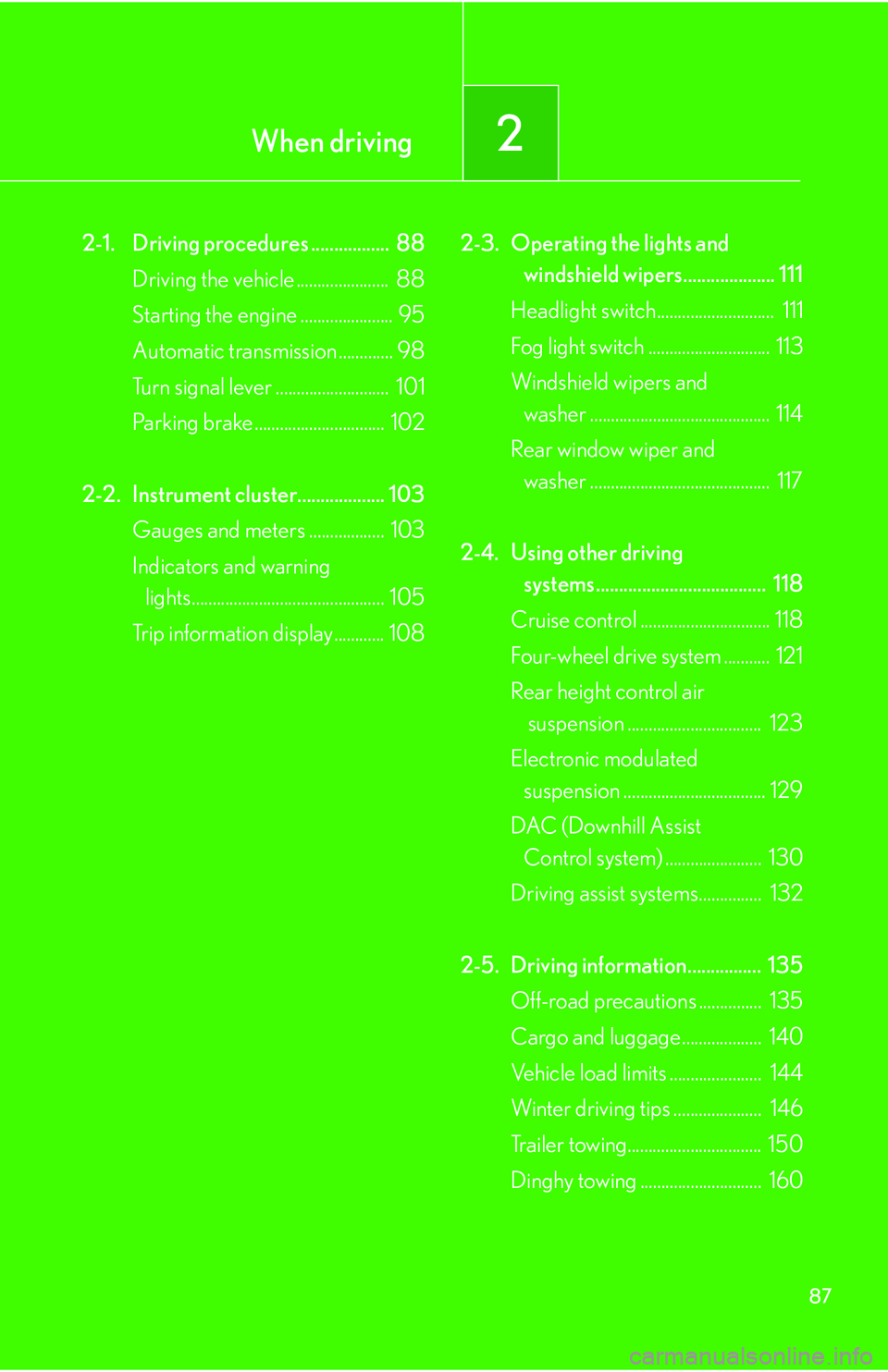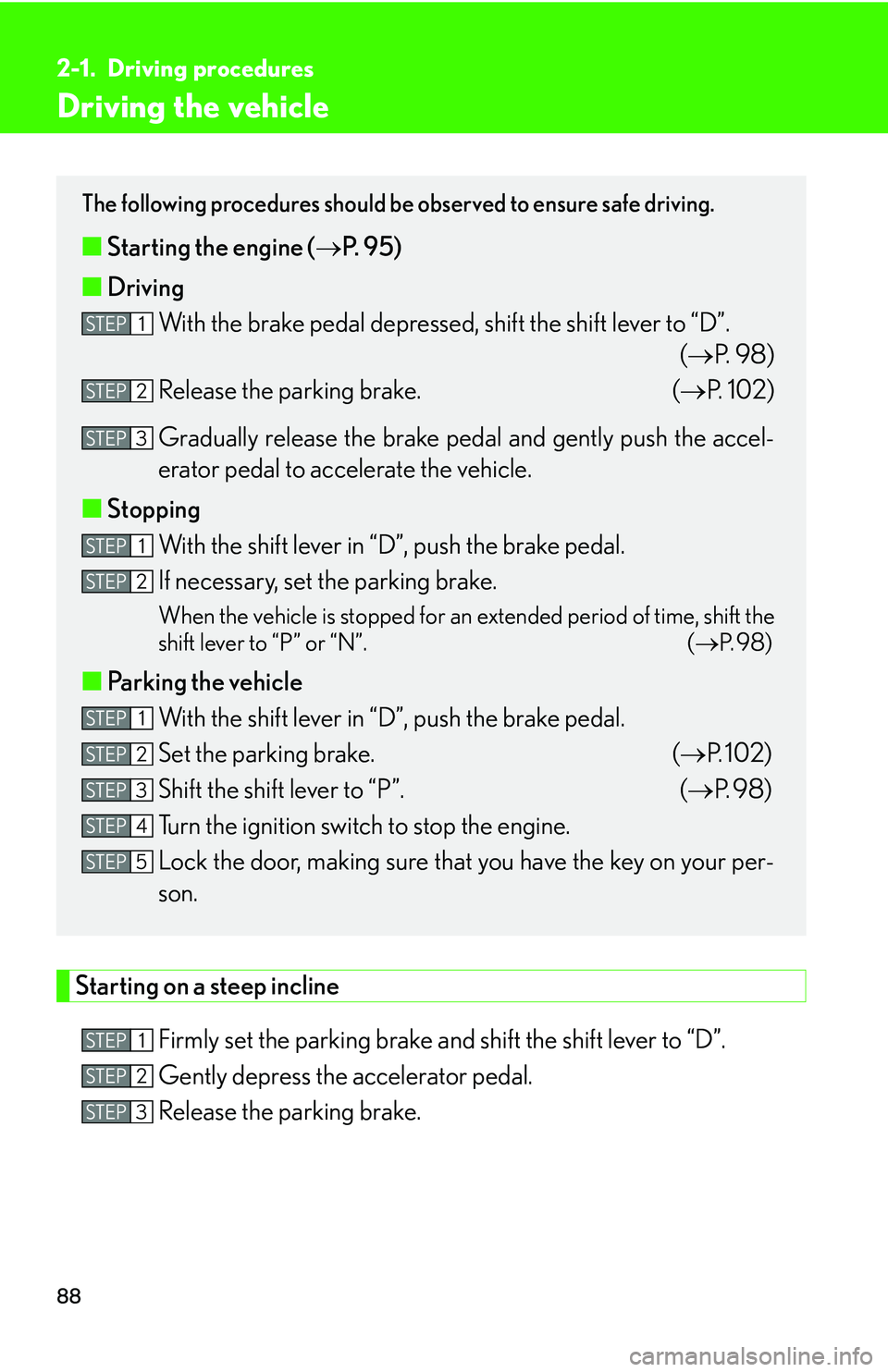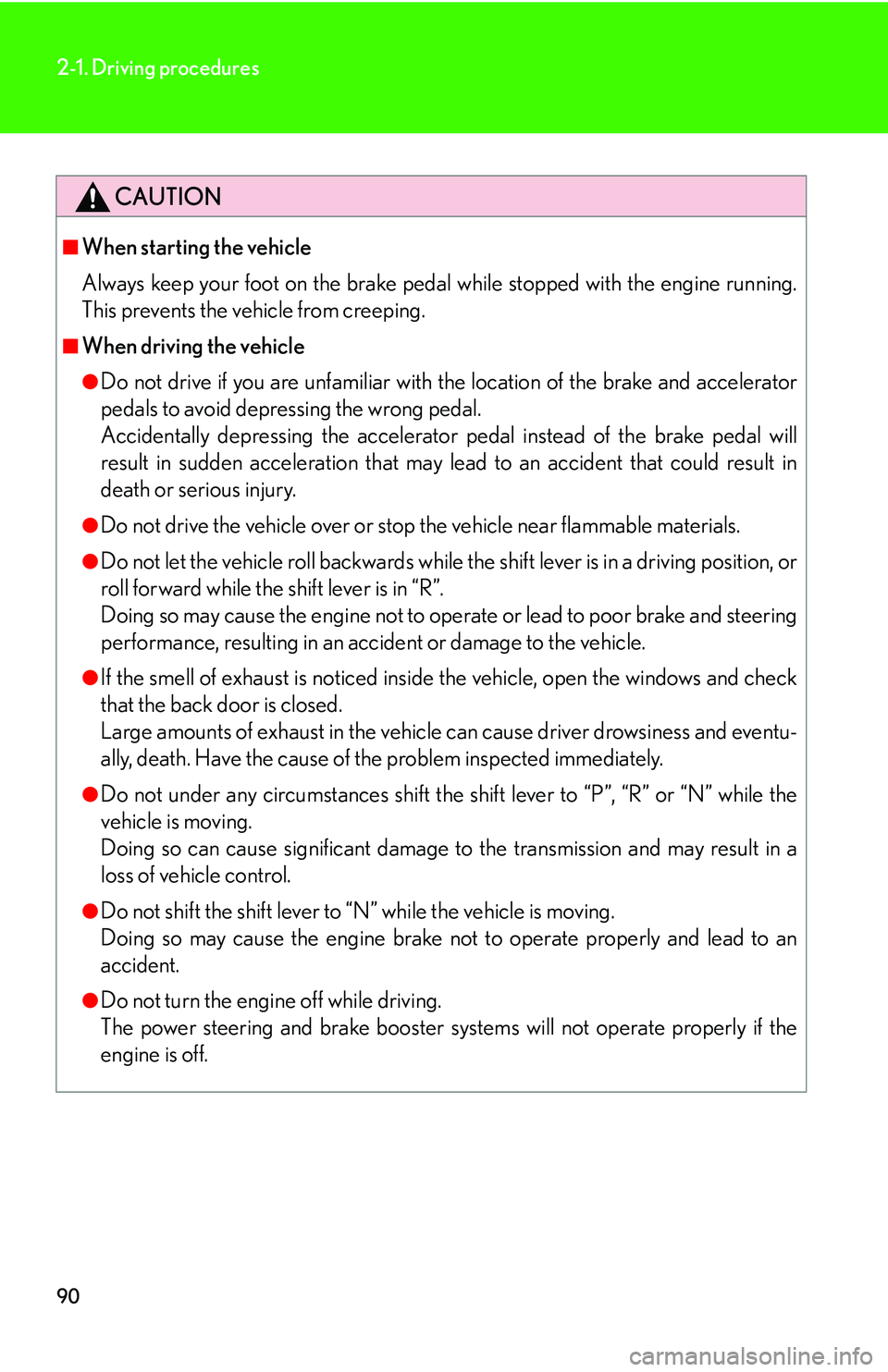Lexus GX470 2007 Instrument cluster / LEXUS 2007 GX470 OWNER'S MANUAL (OM60C64U)
Manufacturer: LEXUS, Model Year: 2007, Model line: GX470, Model: Lexus GX470 2007Pages: 436, PDF Size: 11.52 MB
Page 101 of 436

81
1-7. Safety information
1
Before driving
Removing a child restraint installed with a seat beltPush the buckle release button
and fully retract the seat belt.
Installation with child restraint lower anchoragesFold the seatback forward and
then back to the 1st lock position
(most upright position) until it locks
into place. Adjust the seatback to
the 5th lock position.1st lock position
5th lock position
Page 102 of 436

82
1-7. Safety information
Type AWiden the gap between
the seat cushion and seat-
back slightly.
Latch the hooks of the
lower straps onto the
anchorages.
If the child restraint has a top
strap, the top strap should be
latched onto the anchorage.
For owners in Canada:
The symbol on a child restraint sys-
tem indicates the presence of a
lower anchorage system.
Type B Widen the gap between
the seat cushion and seat-
back slightly.
Latch the buckles onto the
anchorages.
If the child restraint has a top
strap, the top strap should be
latched onto the anchorage.
For owners in Canada:
The symbol on a child restraint sys-
tem indicates the presence of a
lower anchorage system.
Canada only
STEP1
STEP2
Canada only
STEP1
STEP2
Page 103 of 436

83
1-7. Safety information
1
Before driving
Child restraint systems with a top strapSecure the child restraint using a
seat belt or lower anchors, and
remove the head restraint.
Open the anchor bracket cover,
latch the hook onto the anchor
bracket and tighten the top strap.
Make sure the top strap is securely
latched.
Reinstall the head restraint.
STEP1
STEP2
STEP3
■Laws and regulations pertaining to anchorages
Anchorages conform to FMVSS225 or CMVSS210.2.
Child restraint systems conforming to FMVSS213 or CMVSS213 specifications
can be used.
This vehicle is designed to conform to the SAE J1819.
Page 104 of 436

84
1-7. Safety information
CAUTION
■When installing a booster seat
Do not fully extend the shoulder belt to prevent the belt from going to ALR lock
mode: ( P. 31)
●ALR mode causes the belt to tighten only which could cause injury or discomfort
to the child.
●Do not allow the child to play with the seat belt or the child could be killed or seri-
ous injured.
■When installing a child restraint system
Follow the directions given in the child restraint system installation manual and fix
the child restraint system securely in place.
If the child restraint system is not correctl y fixed in place, the child may be injured or
even killed in the event of sudden braking or an accident.
●If the driver’s seat interferes with the child
restraint system and prevents it from being
attached correctly, attach the child restraint
system to the right-hand rear seat.
●Only put a forward facing or booster child
seat on the front seat when unavoidable.
When installing a forward facing or
booster child restraint on the front passen-
ger seat, move the seat as far back as possi-
ble even if the “AIRBAG OFF” indicator
light is illuminated. Failing to do so may
result in death or serious injury if the air-
bags deploy (inflate).
Page 105 of 436

85
1-7. Safety information
1
Before driving
CAUTION
■When installing a child restraint system
●When a booster seat is installed, always ensure that the shoulder belt is posi-
tioned across the center of the child's shoulder. The belt should be kept away
from the child's neck, but not so that it could fall off the child's shoulder. Failing to
do so may result in death or serious inju ry in the event of an accident or sudden
braking.
●Ensure the belt and tab are securely locked and that the seat belt is not twisted.
●Push and pull the child seat in different directions to be sure it is secure.
●Follow all installation instructions provid ed by the child restraint system manufac-
turer.
■Do not use a seat belt extender
If a seat belt extender is used when inst alling a child restraint system, the seat belt
will not securely hold the child restraint system, which could cause death or serious
injury to the child or other passengers in the event of a collision.
●When installing a child restraint system in
the third center position, set the both seat-
backs to the same an gle. Otherwise, the
child restraint system cannot be properly
secured.
Page 106 of 436

86
1-7. Safety information
CAUTION
■To correctly attach a child restraint system to the anchorages
●When using the lower anchorages, be sure that there are no foreign objects
around the anchorages and that the seat belt is not caught behind the child seat.
Make sure the child restraint system is se curely attached, or it may cause death or
serious injury to the child in the event of a sudden stop or accident.
●When using the left side lower anchorages
for the child restraint system, do not sit in
the center seat. Seat belt function may be
impaired, such as being positioned overly
high or loose-fitting, which may result in
death or serious injury in the event of a col-
lision.
Page 107 of 436

When driving2
87
2-1. Driving procedures ................. 88Driving the vehicle ...................... 88
Starting the engine ...................... 95
Automatic transmission ............. 98
Turn signal lever ........................... 101
Parking brake ............................... 102
2-2. Instrument cluster................... 103 Gauges and meters .................. 103
Indicators and warning lights.............................................. 105
Trip information display............ 108 2-3. Operating the lights and
windshield wipers.................... 111
Headlight switch............................ 111
Fog light switch ............................. 113
Windshield wipers and washer ........................................... 114
Rear window wiper and washer ........................................... 117
2-4. Using other driving systems ..................................... 118
Cruise control ............................... 118
Four-wheel drive system ........... 121
Rear height control air suspension ................................ 123
Electronic modulated suspension .................................. 129
DAC (Downhill Assist Control system) ....................... 130
Driving assist systems............... 132
2-5. Driving information................ 135 Off-road precautions ............... 135
Cargo and luggage................... 140
Vehicle load limits ...................... 144
Winter driving tips ..................... 146
Trailer towing................................ 150
Dinghy towing ............................. 160
Page 108 of 436

88
2-1. Driving procedures
Driving the vehicle
Starting on a steep inclineFirmly set the parking brake and shift the shift lever to “D”.
Gently depress the accelerator pedal.
Release the parking brake.
The following procedures should be observed to ensure safe driving.
■ Starting the engine ( P. 9 5 )
■ Driving
With the brake pedal depressed, shift the shift lever to “D”. (P. 9 8 )
Release the parking brake. ( P. 1 0 2 )
Gradually release the brake peda l and gently push the accel-
erator pedal to accelerate the vehicle.
■ Stopping
With the shift lever in “D”, push the brake pedal.
If necessary, set the parking brake.
When the vehicle is stopped for an extended period of time, shift the
shift lever to “P” or “N”. ( P. 9 8 )
■Parking the vehicle
With the shift lever in “D”, push the brake pedal.
Set the parking brake. ( P. 1 0 2 )
Shift the shift lever to “P”. ( P. 9 8 )
Turn the ignition switch to stop the engine.
Lock the door, making sure that you have the key on your per-
son.
STEP1
STEP2
STEP3
STEP1
STEP2
STEP1
STEP2
STEP3
STEP4
STEP5
STEP1
STEP2
STEP3
Page 109 of 436

89
2-1. Driving procedures
2
When driving
■Breaking in your new Lexus
To extend the life of the vehicle, the following precautions are recommended to
observe:
●For the first 200 miles (300 km):
Avoid sudden stops.
●For the first 500 miles (800 km):
Do not tow a trailer.
●For the first 600 miles (1000 km):
• Do not drive at extremely high speeds.
• Avoid sudden acceleration.
• Do not drive continuously in the low gears.
• Do not drive at a constant speed for extended periods.
■Operating your vehicle in a foreign country
Comply with the relevant vehicle registration laws and confirm the availability of the
correct fuel. (P. 3 8 0 )
Page 110 of 436

90
2-1. Driving procedures
CAUTION
■When starting the vehicle
Always keep your foot on the brake pedal while stopped with the engine running.
This prevents the vehicle from creeping.
■When driving the vehicle
●Do not drive if you are unfamiliar with the location of the brake and accelerator
pedals to avoid depressing the wrong pedal.
Accidentally depressing the accelerator pedal instead of the brake pedal will
result in sudden acceleration that may lead to an accident that could result in
death or serious injury.
●Do not drive the vehicle over or stop the vehicle near flammable materials.
●Do not let the vehicle roll backwards while the shift lever is in a driving position, or
roll forward while the shift lever is in “R”.
Doing so may cause the engine not to oper ate or lead to poor brake and steering
performance, resulting in an accident or damage to the vehicle.
●If the smell of exhaust is noticed inside the vehicle, open the windows and check
that the back door is closed.
Large amounts of exhaust in the vehicle can cause driver drowsiness and eventu-
ally, death. Have the cause of the problem inspected immediately.
●Do not under any circumstances shift the shift lever to “P”, “R” or “N” while the
vehicle is moving.
Doing so can cause significant damage to the transmission and may result in a
loss of vehicle control.
●Do not shift the shift lever to “N” while the vehicle is moving.
Doing so may cause the engine brake not to operate properly and lead to an
accident.
●Do not turn the engine off while driving.
The power steering and brake booster systems will not operate properly if the
engine is off.